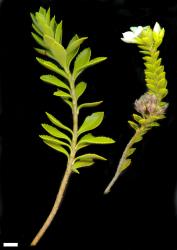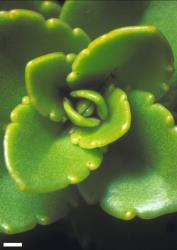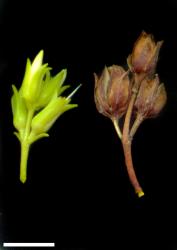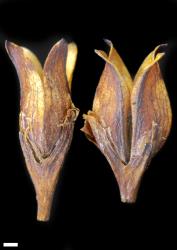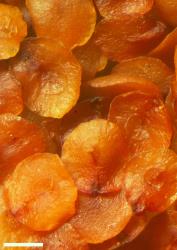- ≡ Hebe macrantha (Hook.f.) Cockayne & Allan, Trans. New Zealand Inst. 57: 43 (1926)
- ≡ Parahebe macrantha (Hook.f.) Heads, Bot. J. Linn. Soc. 115: 79 (1994)
Shrub to 0.5 m tall. Branches decumbent to erect, glabrous, or young branches eglandular-puberulent; hairs uniform or bifarious. Leaf bud indistinct; leaves separating while very small, opposite-decussate, erecto-patent to spreading; lamina coriaceous, oblanceolate or elliptic to obovate or sub-orbicular, 5.5–30.0 mm long, 2.5–13.0 mm wide, dull green above and beneath; midrib evident; surfaces glabrous; margins glabrous or sparsely ciliolate, serrate with 1–7 (rarely to 11) pairs of teeth or rarely entire; apex sub-acute to obtuse; base cuneate; petiole 0.5–5.5 mm long. Inflorescence a lateral raceme, 8–57 mm long; flowers crowded, 2–7, all bisexual; bracts opposite below, becoming alternate above, narrowly deltoid to linear, > pedicels; pedicels erect to sub-erect, 5–15 mm long, puberulent all around or rarely glabrous. Calyx lobes 4, acuminate, 5–10 mm long, unequal, puberulent inside, mixed eglandular- and glandular-ciliolate. Corolla 16–23 mm diameter; tube white and greenish-yellow, 4.5–5.5 mm long, < calyx, glabrous; lobes 4, white, sub-erect to spreading, sub-equal, narrowly elliptical to elliptical or ovate, 8–10 mm long, obtuse; nectar guides absent. Stamen filaments white, 8.0–9.5 mm long; anthers creamy white to yellowish. Style glabrous, 5.5–9.3 mm long. Capsules angustiseptate, acute to attenuate, glabrous, 6.0–12.5 mm long, 4.5–6.5 mm at widest point. Seeds ellipsoid to discoid, flattened, smooth, pale brown, 1.5–2.7 mm long.
| 1 | Lamina elliptic to broadly elliptic; marginal teeth in 1–5 pairs; lowermost inflorescence bracts 2–4 (rarely –8) mm long | var. brachyphylla |
| Lamina mostly oblanceolate, rarely lanceolate to elliptic; marginal teeth in 2–12 pairs; lowermost inflorescence bracts 4–9 mm long | var. macrantha |
Veronica macrantha is easily recognised. Plants have coriaceous toothed leaves that are similar in shape to those of the speedwell hebes and the sun hebes. However, their few-flowered inflorescences, large flowers, and acute capsules are points of difference from those groups (although the inflorescences are similar to those of V. linifolia and V. colostylis, distinguished by their linear entire leaves). Most speedwell hebes (e.g., V. decora) have coloured nectar guides on the corolla and lax, simple racemes, whereas sun hebes (e.g. V. hulkeana) have sessile or sub-sessile flowers in terminal compound racemes or spikes.
South Island: Western Nelson, Sounds Nelson, west and south-west Marlborough, Westland, Canterbury (in the west), Otago (north-west), northern Fiordland.
Penalpine grassland and low shrubland mostly in the wetter mountains near the main divide. Recorded elevations range from 760 to 1910 m.
| Category | Number |
|---|---|
| Indigenous (Endemic) | 2 |
| Total | 2 |
Flowers: November–April; fruits: December–May, persisting all year.
2n = 42 (see Bayly & Kellow 2006, as Hebe macrantha).
Veronica macrantha is classified in V. subg. Pseudoveronica sect. Hebe and the informal group “Grandiflorae” (Albach & Meudt 2010; Bayly & Kellow 2006). Chromosome number and molecular systematics both provide strong evidence that V. macrantha is, or is part of, an early-diverged lineage within the New Zealand clade (V. sect. Hebe), although beyond that its relationships are not clear and differ according to the DNA sequence being analysed (Albach & Meudt 2010). ITS alone places it near the shrubby hebes and V. linifolia, but the short branch lengths and weak support values indicate caution is warranted. Chloroplast DNA alone places it close to the semi-whipcord hebes (V. hookeri and relatives). Using combined nuclear (ITS) and chloroplast (cpDNA) sequences, V. macrantha seems more closely related to the sun hebes and speedwell hebes than to the shrubby hebes.
Variation in morphology and flavonoid chemistry was described by Bayly et al. 2004.



